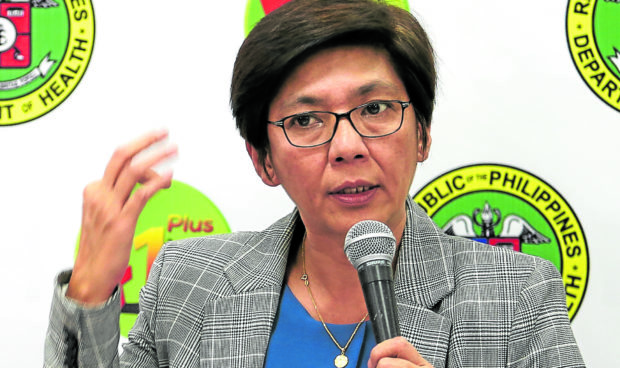DOH warns against complacency as Metro Manila hospitals return to ‘safe zone’
MANILA, Philippines — Along with the downward trend in coronavirus infections in Metro Manila, the region’s health-care utilization rate (HCUR) is back in the “safe zone,” the Department of Health (DOH) said on Monday.
The DOH, however, warned against complacency in following health protocols during the coronavirus pandemic. It said hospital occupancy remained high in several cities and towns in the National Capital Region (NCR) and the nearby provinces of Rizal, Cavite, Laguna and Bulacan, collectively called “NCR Plus.”
“Our health-care utilization rate and ICU (intensive care unit) utilization rate in the NCR is now in the safe zone but still at high risk in some NCR Plus areas,” Health Undersecretary Maria Rosario Vergeire said in a briefing on Monday.
“We should not be complacent. We should be more strict in complying with health standards,” she added.
HCUR refers to the number of ICUs, isolation beds and ventilators currently in use in health and medical facilities in an area.
Article continues after this advertisementBed occupancy rates
The DOH said the occupancy rate of ICU, isolation and ward beds for COVID-19 patients in Metro Manila was at 48 percent, while that of ICU beds was down to 61 percent from a peak of 88 percent last March when cases began to surge.
Article continues after this advertisementOccupancy of beds in makeshift quarantine units was at 36 percent.
Vergeire said local governments in NCR Plus, which were under strict community restriction for nearly two months until last Saturday, should continue to track down COVID-19 cases and make sure all confirmed cases were isolated immediately to reduce virus transmission.
Experts believe that isolating all infected persons within 5.5 days after detection can reduce by as much as two-thirds the total number of cases.
Daily new cases detected in Metro Manila range from 1,700 to 1,800, compared to 4,000 to 5,000 during the surge.
Nationwide, the seven-day moving daily average is 5,886, from a peak of 10,000 cases.
On Monday the DOH recorded 5,979 more infections, pushing total cases to 1,149,925. There were 72 more deaths, including 31 who were previously tagged as recovered, bringing the death toll to 19,262.
Meanwhile, 6,602 more were declared recovered, bringing total recoveries to 1,076,428.
After the recoveries and deaths, there are still 54,235 active cases, of which 93.3 percent are mild, 2 percent asymptomatic, 1.25 percent moderate, 2 percent severe and 1.4 percent critical.
The DOH said 13.1 percent of the 45,210 tested last Saturday were positive for COVID-19.
Five laboratories did not submit their data.
India variant
An infectious diseases expert said it was still difficult to say whether there is already a community transmission of the more transmissible India variant of the virus, as he called for an increased contact tracing, testing, and border control measures.
Dr. Rontgene Solante also urged a closer look at the “severity index,” as another criteria in selecting patients’ samples for genome sequencing.
Genome sequencing is a costly and complicated process currently carried out only by the Philippine Genome Center and the University of the Philippines’ National Institutes of Health to trace the variants of concern in COVID-19 patients.
Solante said severity index would mean looking into the samples specifically of severe COVID-19 cases to find out whether their worsening condition is driven by the B.1.617.2 variant that was first reported in India.
“This (approach) is based on the experience of India, where severe COVID occurs [even] among younger population,” Solante said in a text message on Monday.
The Philippines so far has 12 known cases of the India variant, three detected in seafarers who returned separately in April and nine in the crew members of cargo ship MV Athens.
The Panama-flagged vessel left the country on May 14 after two weeks of seeking refuge for its virus-stricken Filipino crew.
